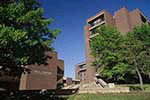List All Events
Algebraic dynamics from topological and holomorphic dynamics
Rohini Ramadas, Harvard
Location: Hill 425
Date & time: Wednesday, 28 February 2018 at 2:00PM - 3:00PM
Let \(f:S^2 \rightarrow S^2\) be an orientation-preserving branched covering from the 2-sphere to itself whose postcritical set
\(P := f^n(x) | x\) is a critical point of \(f\) and \(n>0\) is finite. Thurston studied the dynamics of \(f\) using an induced holomorphic
self-map \(T(f)\) of the Teichmuller space of complex structures on \((S^2, P)\). Koch found that this holomorphic dynamical system on Teichmuller space descends to algebraic dynamical systems:
1. \(T(f)\) always descends to a multivalued self map \(H(f)\) of the moduli space \(M_{0,P}\) of markings of the Riemann sphere by the finite set \(P\).
2. When \(P\) contains a point \(x\) at which \(f\) is fully ramified, under certain combinatorial conditions on \(f\), the inverse of \(T(f)\)
descends to a rational self-map \(M(f)\) of projective space \(P^n\). When, in addition, \(x\) is a fixed point of \(f\), i.e. \(f\) is a
`topological polynomial' \(\rightarrow\), the induced self-map \(M(f)\) is regular.
The dynamics of \(H(f)\) and \(M(f)\) may be studied via numerical invariants called dynamical degrees: the k-th dynamical degree of an algebraic dynamical system measures the asymptotic growth rate, under iteration, of the degrees of k-dimensional subvarieties.
I will introduce the dynamical systems \(T(f)\), \(H(f)\) and \(M(f)\), and dynamical degrees. I will then discuss why it is useful to study \(H(f)\) (resp. \(M(f)\)) simultaneously on several compactifications of \(M_{0,P}\). We find that the dynamical degrees of \(H(f)\) (resp. \(M(f)\)) are algebraic integers whose properties are constrained by the dynamics of \(f\) on the finite set \(P\). In particular, when \(M(f)\) exists, then the more \(f\) resembles a topological polynomial, the more \(M(f): P^n \rightarrow P^n\) behaves like a regular map.



